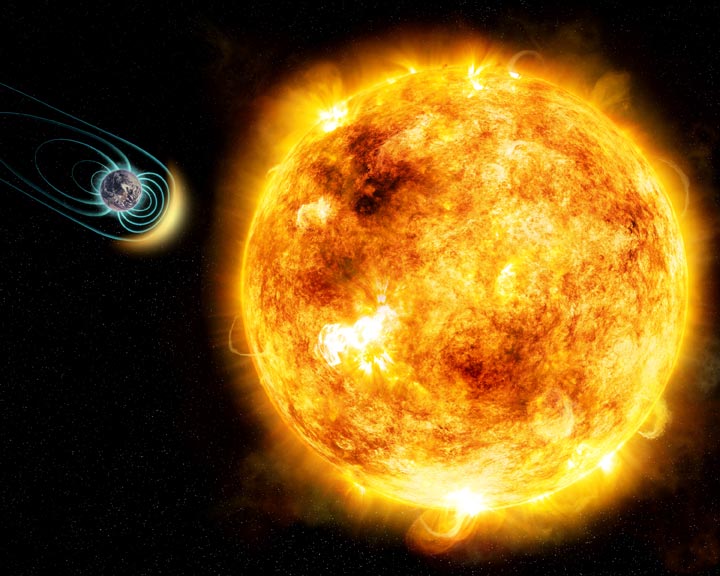Scientists observe first Sun-like magnetic cycle on another star

Artist’s illustration of the young Sun-like star Kappa Ceti, blotched with large starspots, which is a sign of its high level of magnetic activity. Credit: M. Weiss/CfA
An international team of scientists led by the University of Göttingen has observed a Sun-like magnetic cycle on another planet for the first time. The Sun’s magnetic field drives the Sun’s spots and flares and fuels the Solar wind – a torrent of material that streams off our star into space.
The discovery is important not only for stellar physics, but also to understand and predict how the Sun affects the Earth and our technological society through its magnetic activity. The results were published in Astronomy & Astrophysics.
With the advent of dedicated instruments known as stellar spectropolarimeters roughly ten years ago, it became possible to map the magnetic fields of nearby Sun-like stars. Using this new technology at the Bernhard Lyot Telescope in the French Pyrenees, the scientists observed the star 61 Cyg A over a period of nine years. Lying in the northern constellation of Cygnus, 61 Cyg A is somewhat smaller and less massive than the Sun, and at a distance of just over eleven light years it is one of the Sun’s nearest neighbours.
The Sun’s activity varies over the course of a 22-year long magnetic cycle, with the polarity of its magnetic field flipping every eleven years. The frequency and strength of these activities wax and wane over the course of a cycle, with two active periods interspersed with more quiet ones. All in all, the variations are relatively small and slow – a stark contrast to the great bulk of known magnetically active stars that vary dramatically in brightness, release enormous flares and display much more complex long-term variability.
Although 61 Cyg A is a little dimmer and cooler than the Sun, the scientists were able to detect changes in its activity coinciding with polarity flips over a seven-year activity cycle, for a magnetic cycle of 14 years. They observed polarity changes every seven years and an increased complexity in its magnetic field when these flips were approached.
“Our findings could contribute greatly towards creating models of how the Sun and other stars generate magnetic fields. This will enable us to gain an understanding of this important process, which is thought to be operating inside all Sun-like stars, and to help us to further understand our own Sun,” explains Sudeshna Bodo Saikia, Ph.D. student at Göttingen University and lead author of the study. A better understanding of this process and of our Sun in general will increase our ability to predict the impact of the Sun’s activities on our technology on Earth and on orbiting satellites.
The Solar wind and coronal mass ejections can indeed have a huge impact on Earth. When these flows of plasma reach Earth, they not only produce the northern and southern lights, but they can also disturb radio communication and power grids at ground level, as well as damage satellites and even threaten astronauts in Earth orbit.
Original publication: Sudeshna Boro Saikia et al. A solar-like magnetic cycle on the mature K-dwarf 61 Cygni A (HD 201091). Astronomy & Astrophysics 2016. Doi: 10.1051/0004-6361/201628262.
Contact:
Sudeshna Bodo Saikia
University of Göttingen
Faculty of Physics – Institute for Astrophysics
Friedrich-Hund-Platz 1, 37077 Göttingen, Germany
Phone +49 551 39-13286
Email: sudeshna@astro.physik.uni-goettingen.de
Web: http://www.astro.physik.uni-goettingen.de/~sudeshna
Media Contact
All latest news from the category: Physics and Astronomy
This area deals with the fundamental laws and building blocks of nature and how they interact, the properties and the behavior of matter, and research into space and time and their structures.
innovations-report provides in-depth reports and articles on subjects such as astrophysics, laser technologies, nuclear, quantum, particle and solid-state physics, nanotechnologies, planetary research and findings (Mars, Venus) and developments related to the Hubble Telescope.
Newest articles

Superradiant atoms could push the boundaries of how precisely time can be measured
Superradiant atoms can help us measure time more precisely than ever. In a new study, researchers from the University of Copenhagen present a new method for measuring the time interval,…

Ion thermoelectric conversion devices for near room temperature
The electrode sheet of the thermoelectric device consists of ionic hydrogel, which is sandwiched between the electrodes to form, and the Prussian blue on the electrode undergoes a redox reaction…

Zap Energy achieves 37-million-degree temperatures in a compact device
New publication reports record electron temperatures for a small-scale, sheared-flow-stabilized Z-pinch fusion device. In the nine decades since humans first produced fusion reactions, only a few fusion technologies have demonstrated…





















